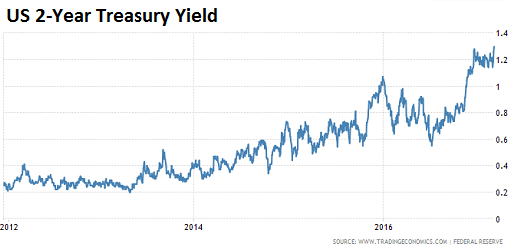

| Online: | |
| Visits: | |
| Stories: |
What’s Different This Time? Stocks
by Wolf Richter, Wolf Street:
 This market (“Dow 30,000”) assures Fed rate hikes.
This market (“Dow 30,000”) assures Fed rate hikes.
The two-year US Treasury yield just shot through 1.33%, the highest since June 2009, when it had briefly spiked from 1% to 1.42%. And that had been the highest since November 2008. It eventually hit a low of 0.16% in September 2011 (via Trading Economics):

This surge in yield is a sign that the bond market is adjusting to a rate hike in March, to more rate hikes later this year, and to more rate hikes next year. The 10-year yield has returned to the 2.5% neighborhood, on its way to take out the recent high set in mid-December of 2.6%.
When yields rise, bond prices fall. So these movements can be painful for the “public” that is holding $14.4 trillion in Treasury securities. The bond market has now gotten the memo after a whole slew of Fed doves have come out this week to flaunt their hawkish sides.
Yesterday, Fed dove Lael Brainard, member of the Fed’s Board of Governors, told a Harvard University audience not only that the fed funds rate should be hiked “soon,” but also that unwinding QE and shrinking the Fed’s balance sheet should enter the discussions.
The bond market took her seriously, though it had ignored Boston Fed president Eric Rosengren who has been making the same noises since last fall. He is specifically worried about the highly leveraged bubble in commercial real estate, and what it might do to lenders once it begins to unravel.
Also on Wednesday, Dallas Fed President Robert Kaplan put a rate hike on the table for March. For him it wasn’t “soon” but “sooner”: “We should begin the process sooner so we can ensure that it is gradual and patient.”
San Francisco Fed President John Williams said a rate hike would be seriously considered at the next meeting and that he sees no reason to wait any longer. On Tuesday, another inveterate dove, a very influential one, New York Fed President William Dudley said that the case for a rate hike has become “a lot more compelling.”
Fed Chair Janet Yellen will speak on Friday. This is the last day on which, according to the Fed’s own rules on public communications, they can try to jawbone the markets before the FOMC meeting on March 14-15.
In response to this onslaught of pronouncements, federal funds futures are now pricing in an 80% chance of a rate hike in March, up from 20% last week.
What’s different this time? Stocks.
The Fed watches the stock market nervously and tries to inflate stock prices as part of the “wealth effect.” And stocks have soared from new high to new high, despite the rate-hike clamor. And that’s different.
For the past six years, even the mere suggestion of removing “accommodation” entailed sharp reactions in the stock market, and soon the Fed felt it had to backtrack. Hence the often stunning flip-flopping.
When, in December 2015, the Fed finally managed to hike the target for the fed funds rate one notch and suggested four more hikes in 2016, it crushed stocks globally for the next eight weeks. It wasn’t until there was concerted flip-flopping on rates by one Fed governor after another that stocks bounced off their mid-February lows and surged for the rest of the year.



